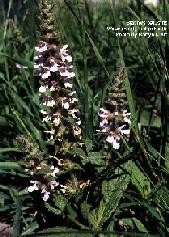

Swamp Hedge-Nettle
Stachys palustris L.
ssp. pilosa (Nutt.) Epling.
Food Uses:
All young shoots, rootstalks, flowers, and seeds are all
edible. The young shoots, despite their smell, were cooked as a vegetable. The
rootstalks, collected in autumn, were dried and ground for use in breads.
They were also eaten raw, pickled, boiled, or baked.
Medical Uses:
Medicinal teas made from plants are used for treating
migraine headaches, sprains, inflamed joints, and inflammations of the
bladder. The plant has been highly valued for its wound-healing
activity, being effective against both internal and external bleeding. The leaves and roots have been used in poultices to reduce pain
and swelling of sprains, joints, and headaches. The herb is harvested in
the summer when just coming into flower and can be dried for later use.
Planting:
Divide in spring. Larger divisions can be planted out direct into their
permanent positions. It is best to pot up the smaller divisions and grow them on
in a lightly shaded position in a cold frame, planting them out once they are
well established in the summer.